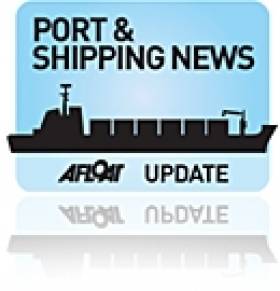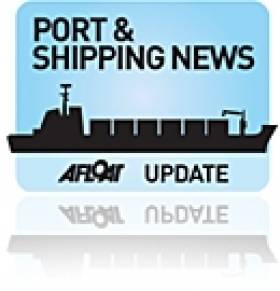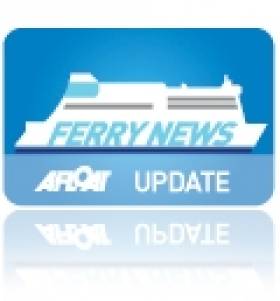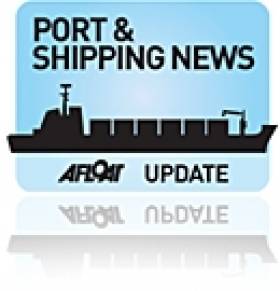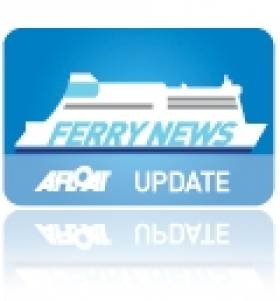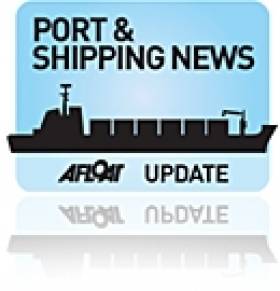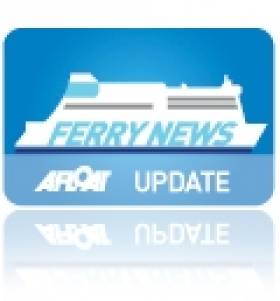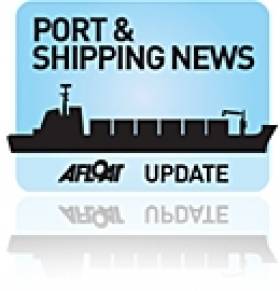Displaying items by tag: Ports & Shipping news
Livestock-Carrier to Restore Trade with Libya
#LivestocktoLibya – A livestock-carrier docked in Waterford Port yesterday, to restore the trade with Libya, which banned beef imports, following the BSE (mad cow) disease which broke out in Ireland, more than 17 years ago, writes Jehan Ashmore.
Al Mahmoud Express is believed to be operated by a Syrian shipping company. The 7,089 tonnes vessel berthed at Belview, the port's main terminal facility, downriver of the city on the Waterford Estuary. It was back in the 1990's, when the city quays last saw live-stock trading on a more regular basis.
Together the Department of Agriculture and the IFA have been working strenuously to have live cattle exported to North Africa.
IFA Livestock Director Kevin Kinsella said that cattle agents are now buying cattle for live export and are looking for coloured cattle, and continental breeds, Angus and Hereford. Mr Kinsella expressed the hope that the live trade will also resume shortly to Egypt and Lebanon.
Prior to the Panamanian flagged vessel setting sail to Ireland, officials from the Department of Agriculture carried out an inspection of the ship in Turkey, which led to some modifications.
In this first shipment to Libya, up to 2,900 live cattle are to be transported to Tripoli. It is estimated the passage time will take 10 days, with an en-route call to Ceuta, the Spanish enclave which neighbours Morocco.
The cattle kill is likely to be up by up to 150,000 this year, and with this additional outlet will help to keep upward pressure on prices.
Al Mahmoud Express, was previously a 700 capacity vehicle-carrier that regularly called to Irish ports. As the Autoline, the 1983 built vessel ran for United European Car Carriers (U.E.C.C.) and up to several years ago she included calling to Rosslare, before been sold.
Guinness Tanks Face Final Leg from Harbour to Gate
#GuinnessTanks – As previously reported on Afloat.ie, the huge fermentation tanks that arrived at the weekend to Dun Laoghaire Harbour, were today unloaded from the cargsoship Myrte, writes Jehan Ashmore.
The 25m long tanks made of stainless steel, and each weighing 30 tons, were shipped from Rotterdam by the Dutch flagged 6,120 tonnes vessel.
A key factor as to why the general cargoship docked in Dun Laoghaire Harbour rather than Dublin Port, was due to 'logistics', according to shipping agents Celtic Forwarding Ltd.
As the tanks were discharged by two cranes, they were lowered onto the truck-trailers on Carlisle Pier. The final leg of the journey will be undertaken during a night-time operation to Diageo's Guinness (St. James Gate) Brewery.
The 'wide-load' will be carried out in one single convoy or in several transits to the historic city-centre brewery, which is undergoing a major €153m investment programme.
£50m Offshore Wind Terminal Completed in Belfast Harbour
#BelfastWindTerminal - A new £50m offshore wind terminal which has been completed in Belfast Harbour, has been handed over to DONG Energy and ScottishPower Renewables.
As previously reported on Afloat.ie, the terminal, the first purpose-built offshore wind installation and pre-assembly harbour in the UK or Ireland, will be used as a hub to help service a market valued in excess of 100bn. Up to 300 jobs are expected to be created, ranging from welders to electricians and engineers.
The official hand-over was attended by Northern Ireland's First and Deputy First Ministers, Peter Robinson MLA and Martin McGuinness MLA, along with Len O Hagan, Belfast Harbour's Chairman and Brent Cheshire, DONG Energys UK Country Chairman.
DONG Energy has signed a lease for the terminal which will be used initially to support the development of the West of Duddon Sands Wind farm in the Irish Sea, a joint venture between ScottishPower Renewables and DONG Energy. Work on the wind farm has already started and Belfast Harbour has received its first shipment of wind farm components. Its anticipated that the first turbines will depart Belfast this summer for erection at the site.
Welcoming the handover, Len OHagan, Belfast Harbour's Chairman, said: "Delivering this immense project on time and on budget has been a major achievement. This is a historic development for Belfast which has the potential to usher in a major new industry for Northern Ireland a development which is all the more poignant given that this is the Harbours 400th anniversary year".
He added "Over the years the harbour has helped bring other industries to Belfast such as shipbuilding and aerospace by investing heavily in infrastructure and land reclamation. This is a continuation of that strategy and a demonstration of our long-term commitment to enhance the local economy".
The 50-acre terminal, located on the Co. Down side of the port, is the largest single investment in Belfast Harbours 400-year history. Built by local construction company Farrans, the project took 15-months, 750,000 man hours, one million tonnes of stones and 30,000 tonnes of concrete to complete.
The 200,000 m2 facility, large enough to accommodate 30 football pitches, includes a 480m deep-water quayside. Up to three vessels will be able to berth simultaneously with access available around the clock.
Brent Cheshire, DONG Energys UK Country Chairman commented: "Having a bespoke facility at our fingertips will help us plan our offshore construction very effectively and help with our work to lower the cost of offshore wind farms. The site is in an excellent strategic position for DONG Energy as we have several wind farms under development in the Irish Sea. This is a port that can handle the large number of huge pieces of equipment required".
Keith Anderson, ScottishPower Renewables CEO, added: "The facility at Belfast Harbour is one of the most advanced anywhere in the world for the assembly of offshore wind turbines, and we are delighted to be taking over the lease as we start offshore construction on the West of Duddon Sands project.
This marks a significant milestone for the West of Duddon Sands project, and we are sure that Belfast will play a hugely important role in its successful delivery. The investment in Belfast Harbour will ensure that the city has a long-term future as a leader in renewable energy.
Over 100 turbines, each with a rotor diameter of 120m, will be shipped from the new terminal to the West of Duddon Sands project. It will be one of the worlds largest offshore wind farms when it is commissioned in 2014.
The UK is Europes leading offshore wind generator and has plans to develop 11,000 new offshore wind turbines, a quarter of which are expected to be built within 150 nautical miles of Belfast. It is anticipated that 32 gigawatts of electricity, one quarter of the nations electricity needs, will be provided by offshore wind.
Stena Line to Reactivate HSS Service Following Ferry Incident
#FerryDisruption - According to ITV Wales, there was an incident on board the Finnarrow, a ferry on charter to Stena Line, while berthing in Holyhead at the weekend.
Stena Line has confirmed the incident at the Welsh port on Saturday, occured as the ferry was berthing after a sailing from Dublin Port, which involved the ships stabilisers. All 77 passengers and 43 crew were evacuated and the vessel was safely berthed.
The vessel is currently docked in Holyhead undergoing inspections and will remain out of service for the immediate future. Since then sailings by the Finnarrow have been cancelled.
Passengers due to travel on Stena Line's Holyhead-Dublin Port route also operated by the Stena Adventurer, will be accommodated on alternative sailings.
Afloat.ie adds that the HSS fastcraft Stena Explorer is to make an earlier than expected return to the Dun Laoghaire-Holyhead route tomorrow (19 February) so to cover the chartered Finnarrow's sailings, until further notice.
The HSS fastcraft will operate a daily single round-trip service, departing Holyhead at 10.30hrs and from Dun Laoghaire departing at 15.05hrs.
Refloated Airbus Wing-Carrier Leaves UK Waters
#AIRBUSship -As previously reported, the Airbus wing-carriership Ciudad de Cadiz (2009 /15,643grt) which was refloated off Mostyn over a week ago, arrived in Falmouth today, writes Jehan Ashmore.
Following the refloating of Ciudad de Cadiz which had arrived to load the wings, she sailed to Holyhead. The vessel had been anchored off the Anglesey port since last Sunday and where divers were to make hull inspections.
It is understood that Ville de Bordeaux was brought in to Mostyn, so to load the Airbus A380 wings constructed at the BAe factory at Broughton.
The Marseille-registered Ciudad de Cadiz, stayed in Falmouth until this evening, where she is heading for Pasajas, near the Spanish-French border.
Both vessels are jointly operated by French owners Louis Dreyfus Armateurs (through its subsidiary FRET SETAM) and Norwegian vehicle-carrier shipping company, Leif Höegh Autoliners.
Tanks for Guinness Arrive in Dun Laoghaire Harbour
#DunLaoghaire – Last night the Dutch-flagged Myrte (6,120 tonnes) docked in Dun Laoghaire Harbour loaded with fermentation tanks bound for Guinness, writes Jehan Ashmore.
The 10 X 30 tons fermentation tanks are to be discharged during the week and installed in Diageo's Guinness (St. James Gate) plant. The historic city-centre brewery's fermentation plant is to be refurbished as part of a major investment.
The 122m cargoship berthed alongside the former conventional ferry (mail) boat Carlisle Pier, from where the cargo will be taken by road convoy, but travelling overnight to avoid traffic and minimise disruption.
This delivery is part of a 'project' cargo as a further two shipments are scheduled, however it has been many years since cargoships have called to Dun Laoghaire Harbour.
In the late 1980's/early 90's there were relatively frequent calls undertaken by 'reefer' ships, vessels equipped with refrigeration capability carrying perishable products.
Some vessels were instead of the ro-ro design, this allowed refrigerated freight-trailers to be driven onboard the ship which berthed at the port's ferry ramp linkspan.
Euro-Celtic Countdown! as Gathering Looms Over the Horizon
#GatheringVoyage- Passengers booked on a Celtic Link Ferries sailing from France one month from today (15 March) in advance of St. Patrick's Day, will be taking advantage of a special €1 euro 'Gathering' fare, writes Jehan Ashmore.
The special offer was an initiative by CLF in this year-long Gathering of events and next month's National Day of festivities.
Celtic Horizon operates three round-trip sailings weekly and among the 27,522 tonnes ro-pax facilities are the Cherbourg Café, Tuskar Lounge and Rosslare Bar. In addition there are a choice of cabin accommodation for the overnight 17-hour crossing between Normandy and Wexford.
Rory McCall, passenger sales manager said "Celtic Link Ferries will ensure that passengers get great value crossings to and from France all year long in 2013. It is only fitting that we give our passengers the best value deal ever between France and Ireland on 15 March".
This month CLF celebrate their eighth year in service, having taken over the route in 2005, following the closure of the service the previous year run by P&O Ferries.
Shipping Scene Highlights Busy Port of Drogheda
#BusyPort – Within the last 48 hours, Drogheda Port will have had nine cargoships that have either docked or lay at anchor, writes Jehan Ashmore.
The busy shipping scene is just a snapshot taken so far in early 2013 and follows the ports handling of more than 1m tonnes of cargo last year.
Export volumes and product types continue to increase as Irish companies seek to export and rely less on the home market. A number of specialist machine and metal fabrication products have recently been shipped from the port.
These nine cargoships have sailed across the Bay of Biscay and as far as the Baltic Sea and carrying a diverse range of imports and exports as outlined below.
Merle which arrived from Passajes, northern Spain with steel, Sergey Kuznetsov, a Russian flagged vessel berthed with bulk-cargo and Amazon Diep laden with timber.
A further three vessels, each loaded with bulk-cargos are the Sagabank, having sailed from Hamburg, Wilson Reef, owned by Norwegian owners and sailed from Rotterdam, while Nephrite had come from further afield having departed Klipeda in Lithuania.
The remaining trio of vessels all with export cargoes are Richelieu, which sailed from Liverpool to load machinery, Arklow Ruler, having transitted the Manchester ship canal, to load bulk cargo and Hohe Bank from Ayr to load fabricated units.
As demonstrated the shipping industry sector involves many ports, varying routes distances and variety of cargoes, not to mention the national backround of the ships themselves.
P&O Ferries Protests Over Eurotunnel Bid to run French Ports
#StraitofDover– Dover's largest ferry operator P&O Ferries have written to the UK Office of Fair Trading, expressing concern over Eurotunnel's inclusion in a final round process to manage French shortsea ports Calais and Boulogne.
The Channel Tunnel operator's move could lead to 'substantial lessening of competition' in shortsea services between the UK and France.
Chief executive of P&O Ferries, Helen Deeble, said a successful bid by the Channel Tunnel operator could lead to a "substantial lessening of competition" in shortsea services between the UK and France.
Calais and Boulogne, owned by the Nord Pas de Calais Chamber of Commerce, comprise two of the three French shortsea ports serving ro-ro traffic out of the UK.
Ms Deeble, who is also the current president of the UK Chamber of Shipping, said a successful Eurotunnel bid would amount to a "relevant merger" within the Enterprise Act 2002, providing grounds for the OFT to investigate.
P&O Ferries, owned by Dubai World, further argues that the ports of Calais and Boulogne "would cease to be distinct from Eurotunnel" and that £70m ($109.8m) of UK derived turnover would be acquired by Eurotunnel.
As a result, said P&O Ferries: "More than 25% of France-based French sea port services for ex-UK ferry traffic is or will be provided by a single entity, Eurotunnel."
For much more on this story Lloyd's List has a report.
Ports & Shipping Review: Fenit’s Crane Exports, Cork’s Energy Deal, Belfast’s Tonnage Record, Grounded Airbus Wingship Re-floated plus more…
P&SReview – Over the last fortnight, Jehan Ashmore has reported from the shipping scene, where the Stade, a cargo vessel rode out bad weather before docking at Fenit to load cranes built by Liebherr in Killarney, which as previously reported has received an order from the New Zealand port of Lyttelton.
The Port of Cork Company have signed up with Sustainable Energy Authority of Ireland (SEAI) in targets for improved energy efficiency set for 2020.
Drogheda Port handled over 1m tonnes of cargo, this level in throughput has not been surpassed since 2007. The Co. Louth port is to welcome a flotilla of tallships during the Drogheda Fringe Festival over the May Bank holiday.
For the first time, Paris will host this year's European (Shortsea '13) Conference on 14 March at La Defense. Last year the IMDO hosted the event in Dublin's Mansion House.
Ports across Europe urged governments not to touch the envelope of €31.7billion foreseen for Europe's transport infrastructure investments under the Connecting Europe Facility (CEF).
Belfast Harbour had a record 19.6m tonnes in 2012, up 11% on the previous year. The growth was primarily driven from the bulk and roll-on/roll-off (freight) sectors.
Irish Ferries fast-craft catamaran Jonathan Swift, returned fresh from dry-docking, she operates the Dublin-Holyhead route, where she clocks up an impressive 162,000kms each year.
A grounded ship that carries wings for the Airbus A380, Ciudad de Cadiz (2008/15,643grt) was re-floated yesterday, having broke moorings during a gale in late January off the Welsh port of Mostyn.


























